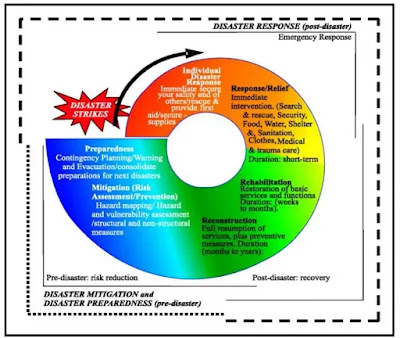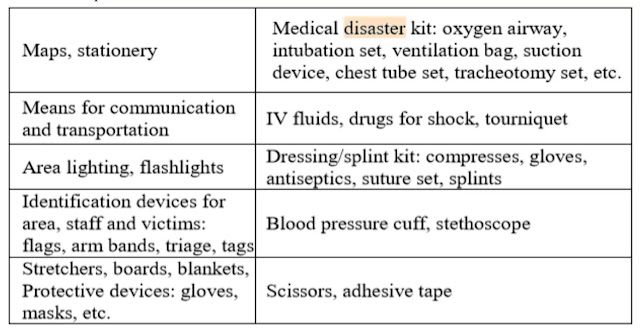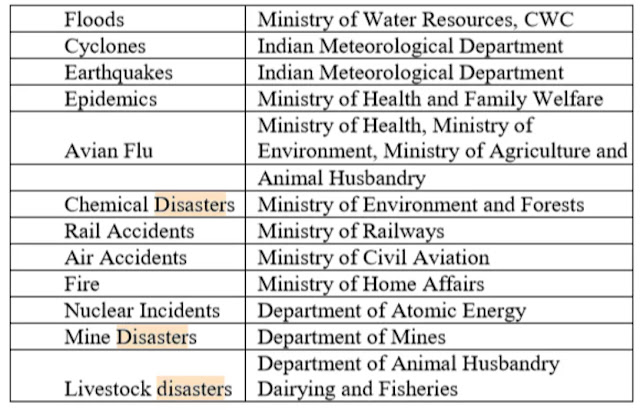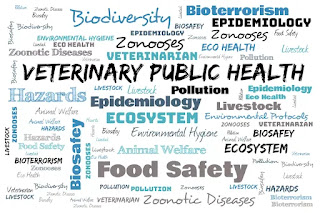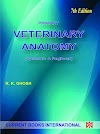(Part 8, Environmental Hygiene, VPE)
Topic: 'Disaster Management and Mitigation'. All Types of Disaster Managements. Livestock Management in Disaster. Role of Veterinarians in Disaster. Agencies of Disaster management in India. Common Diseases during Disaster. Basic needs in Disaster.
Disaster Management
Introduction
Disaster management refers to a proactive approach which aims to reduce the negative impact or consequences of adverse events and is not merely response and relief. The term ‘reduce’ is used here since disasters cannot always be prevented, but the adverse effects can be minimized. It is a multi-system process based on the key principles of planning, organizing, and leading in addition to coordinating and controlling.
Because of its large geographical size, India often faces natural calamities like earthquakes, floods, cyclones, drought and landslides occurring frequently in different parts of the country. Natural disasters in India are recurrent phenomena. About 60% of the landmass is prone to earthquakes of various intensities; over 40 million hectares is prone to floods; about 8% of the total area is prone to cyclones and 68% of the area is susceptible to drought (NDMA, 2008). Natural disasters cannot be prevented, but their impact on people’s and animals’ lives can be reduced to a considerable extent. A lack of well-developed disaster management plan results in a severe loss of human and animal life and property. Most disasters can be predicted (flood, cyclone, drought) and some are unpredictable which strike suddenly (earthquake) and disrupt socio-economic life. It is quite often a panicky situation where all services are disrupted. Longer the period of external rescue and relief operations, more is the suffering of the affected communities. Animal are abandoned by the owners, dying and lying wherever they are, unattended, rotting, giving scope for epidemics.
Emergency vs Disaster situation
An emergency and a disaster are two different situations: Emergency refers to a situation in which the community is capable of coping. It is a situation generated by the real or imminent occurrence of an event that requires immediate attention of emergency resources.
On the other hand, a disaster is a situation in which the community is incapable of coping. It is a natural or human caused event which causes intense negative impacts on people, goods, services and/or the environment, exceeding the affected community’s capability to respond; therefore, the community seeks the assistance of government and international agencies.
Types of disasters
Disasters are often classified according to their causes as either natural or man-made and based on the speed of onset as sudden or slow.
I. Natural Disasters -
These types of disaster naturally occur in proximity to people, structures or economic assets and pose a threat to life and assets. They are caused by biological, geological, seismic, hydrologic, or meteorological conditions or processes in the natural environment.
1. Cyclones, Hurricanes or Typhoons
Cyclones develop when a warm ocean gives rise to hot air, which in turn creates convectional air currents. Cyclones occur when these conventional air currents are being displaced. The term hurricane/typhoon is a regionally specific name for a “tropical cyclone”. In Asia they are called ‘typhoons’; in the Indian and Pacific Oceans they are called 'cyclones'; and over the North Atlantic and Caribbean Basin, they are called 'hurricanes'.
2. Earthquakes
An earthquake is a trembling or shaking movement of the earth’s surface, resulting from plate movements along a fault-plane or as a result of volcanic activity. Earthquakes can strike suddenly, violently, and without warning at any time of the day or night.
3. Tsunami
A tsunami is a series of water waves generated by a submarine earthquake, volcano or underwater explosions, meteorite impacts or other disturbances above or below the water surface have the potential to generate tsunamis. The infamous 2004 Indian Ocean tsunami is the deadliest of natural disasters killing nearly 230,000 in 14 nations bordering the Indian Ocean. The deadly potential of tsunamis is potentiated by the fact that the intensity of a tsunami is very tough to predict even when the location and scale of the earthquake is known.
4. Floods
This phenomenon occurs when water covers previously dry areas, i.e., when large amounts of water flow from a source such as a river onto a previously dry area, or when water overflows banks or barriers.
5. Landslides
The term landslide refers to the downward movement of masses of rock and soil. Landslides are caused by one or a combination of factors like change in slope gradient, increasing the load on the land, shocks and vibrations, change in water content, ground water movement, and removal or changing the type of vegetation covering slopes, rains, floods, earthquakes, etc.
II. Man-made Disasters -
These are disasters or emergency situations of which the principal, direct causes are identifiable human actions, deliberate or otherwise. Apart from “technological disasters” this mainly involves situations in which civilian populations suffer casualties, losses of property, basic services and means of livelihood as a result of war, civil strife or other conflicts, or policy implementation. In many cases, people are forced to leave their homes, giving rise to congregations of refugees or externally and/or internally displaced persons as a result of civil strife, an airplane crash, a major fire, oil spill, epidemic, terrorism, etc.
Classification based on speed of onset:
- Sudden onset: Little or no warning, minimal time to prepare. For example, an earthquake, tsunami, cyclone, volcano, etc.
- Slow onset: Adverse event slow to develop; first the situation develops; the second level is an emergency; the third level is a disaster. For example, drought, civil strife, epidemic, etc.
Complex Disasters
Some disasters can result from multiple hazards, or, more often, to a complex combination of both natural and man-made causes which involve a break-down of authority, looting and attacks on strategic installations, including conflict situations and war. These can include -
- Food Insecurity
- Epidemics
- Armed Conflicts
- Displaced Populations
According to ICRC these Complex Emergencies are typically characterized by
- Extensive Violence
- Displacements of Populations
- Loss of Life
- Widespread Damage to both Societies and Economies
- Need for Large-scale, Humanitarian Assistance across Multiple Agencies
- Political and Military Constraints which impact or prevent Humanitarian Assistance
- Increased Security Risks for Humanitarian Relief Workers
Pandemic Disasters
Pandemic is an epidemic of infectious disease that has spread across a large region, which can occur to the human population or animal population and may affect health and disrupt services leading to economic and social costs. It may be an unusual or unexpected increase in the number of cases of an infectious disease which already exists in a certain region or population or can also refer to the appearance of a significant number of cases of an infectious disease in a region or population that is usually free from that disease. Pandemic Emergencies may occur as a consequence of natural or man-made disasters. These have included the following epidemic.
- Ebola
- Zika
- Avian Flu
- Cholera
- Dengue Fever
- Malaria
- Yellow Fever
- Coronavirus Disease (COVID-19)
Disaster Management Cycle
Disaster management is a cyclical process: the end of one phase is the beginning of another, although one phase of the cycle does not necessarily have to be completed in order for the next to take place. Often several phases take place concurrently. Timely decision making during each phase results in greater preparedness, better warnings, reduced vulnerability and/or the prevention of future disasters. The complete disaster management cycle includes:
1. Mitigation (preventing or minimizing the effects of future emergencies):
This phase includes activities that prevent an emergency, reduce the likelihood of occurrence, or reduce the damaging effects of unavoidable hazards. Mitigation activities should be considered long before an emergency.
2. Preparedness (preparing to handle an emergency):
This phase includes developing plans for what to do, where to go, or who to call for help before an event occurs; actions that will improve your chances of successfully dealing with an emergency. For instance, posting emergency telephone numbers, holding disaster drills, and installing tsunami warning system are all preparedness measures.
3. Response (responding safely to an emergency):
It includes actions taken to save lives and prevent further property damage in an emergency situation. Response is executing the preparedness plans into action. Seeking shelter from a cyclone or leaving out of the buildings at earthquake are both response activities.
4. Recovery (recovering from an emergency):
It includes actions taken to return to a normal or an even safer situation following an emergency. Recovery includes getting financial assistance for the repairs.
Disaster management in animals
With increasing globalization, the persistence of Transboundary Animal Diseases (TADs) anywhere in the world poses a serious risk to the world’s animal, agriculture and food security and jeopardizes international trade. Recent animal health emergencies, including Foot and Mouth Disease (FMD) and bird flu have highlighted the vulnerability of the livestock sector to serious damage by epidemic diseases and its reliance on efficient animal health services and practices at all levels. The significance of animal diseases (including zoonoses) on human health and welfare is also being increasingly recognized.
Epidemics, epizootics, respiratory diseases, parasites (internal and external), other bacterial and vector-borne diseases occur after most of disasters. Usually post-disaster relief measures are focused on the human beings as first priority. Due to many reasons, livestock get little or no attention. This makes animals more vulnerable to disasters than human beings and the resulting impact of disasters on animals is high and long lasting. Under disaster situations, due to extreme stress, immunity goes down, coupled with starvation, the animals as well as human beings become more susceptible to infections, diseases with the associated risk of spread in the form of epidemic. The role of veterinary departments and veterinarians becomes crucial in such a situation.
The risk of epidemics increases after natural disasters because of exposure to many kinds of disease-causing bacteria, viruses, fungi and parasites spread by flood waters, debris and stress that lowers the immunity combined with animal housing in emergency animal shelters where communicable disease agents build up in the environment and pass to others.
Some common diseases encountered post disaster
These diseases should be monitored and where appropriate, animal disease control procedures should be implemented to prevent the spread of diseases. In specific instances, restocking should be considered after going through the necessary quarantine period. Vaccination against those epidemics and anthelmintics and treatment campaigns should be made.
Disasters that could lead to an emergency situation in the animal husbandry sector:
Emergency situations in animals may arise primarily due to the following four categories of risks:
(A) Natural Disasters –
As mentioned earlier India is vulnerable to most types of natural disasters and its vulnerability varies from region to region and a large part of the country is exposed to these natural hazards which often turn into disasters, causing a significant disruption of the social andeconomic life of communities arising from the loss of life and property, including livestock.
(B) Infectious Diseases -
Emergency animal diseases are not always the same as exotic or foreign animal diseases. Outbreaks of infectious diseases are of many types:
- Any unusual outbreak of an endemic disease in exponential frequency causing significant change in the epidemiological pattern of that particular disease.
- The appearance of a previously unknown disease in a particular region.
- Animal health emergencies caused due to non-disease events, for example, a major chemical residue problem in livestock or a food safety problem such as hemorrhagic uraemic syndrome in humans caused by the contamination of animal products by verotoxic strains of E. coli.
- Deliberate introduction of exotic microorganisms in a targeted region.
(C) Fodder Poisoning -
Accumulation in chemicals in plants leads to poisoning which is a potential danger to grazing animals. In order to keep a check on such cases, awareness among the local community must be created so that they take proper care of their animals and prevent them from eating poisonous toxic materials. Based on the above approach, the following activities should be undertaken:
- Listing of the various poisonous materials, including braken fern, Lantana camara, parthenium, rati (Abrus prectorus), dhatura (thorn apple), kaner (oleandar); cyanogenic plants like immature maize, sorghum banchari, cereal affected with egrot, India pea; nitrate and nitrite containing plants, etc.; and the measures to prevent the availability of such materials to livestock.
- Exotic/cross breeds are more susceptible to damage under drought conditions than indigenous breeds. Livestock owners will be made aware of how to take proper care of these exotic/cross breeds.
- Certain areas will be demarcated for fodder production. Pastures should also be developed for migratory sheep and goat and clean grain made available for pigs and poultry.
(D) Trans-boundary Animal Diseases-
TADs are a major cause of economic losses to the livestock industry and are those infectious diseases which could spread fast and have the potential to cause considerable mortality or losses in productivity. TADs have the capability to seriously affect earnings from export of livestock or its products.
A TAD epidemic such as avian influenza (bird flu) or FMD has the same characteristics as other natural disasters—it is often a sudden and unexpected event, has the potential to cause major socio-economic consequences of national dimensions and even threaten food security, may endanger human life, and requires a rapid national level response. Some very important diseases of animal husbandry and public health perspectives include:
- Non-zoonotic diseases – FMD, PPR, RP, CSF, CBPP, etc.
- Diseases with known zoonotic potential – Anthrax, BSE, Brucellosis, CCHF, Ebola virus, Food-borne diseases, HPAI, JE, Q fever, Rabies, etc.
(E) Miscellaneous Causes -
India may have remained blissfully unaware of the losses in livestock due to the Bhopal gas tragedy or the consequences of arsenic or other toxic elements that may not only cause acute loss of livestock but are also potentially hazardous for public health as livestock produce is directly related to the human food chain. The impact of major accident hazard units such as nuclear reactors and hazardous waste dumping sites are examples of slow and impending livestock disaster situations.
Role of veterinarians and veterinary service in disasters
During disasters, the role of veterinarians is to ensure high standards of animal health and to reduce mortality among animals. Veterinarians can play a major role in promoting local predisaster planning at community level which places a high priority on facilitating livestock and pet evacuation (Heath, 1999). Veterinarians have a role to play in all stages of disaster mitigation and management, but it is during relief efforts that they can play a crucial role in increasing the survivability of animals that are victims and of those that are deployed in rescue teams. Veterinarians can also instruct their clients on first aid for horses and livestock and advice on the contents and appropriate use of first aid kits. The basic needs in a standard kit are listed in the table.
Minimum requirements for a standard kit - List of basic needs
It is not possible to react effectively and efficiently to a disaster unless the response has been planned well in advance on the basis of a comprehensive risk assessment and unless the measures to be taken by the organizations, institutions and government bodies involved have been co-coordinated and carefully rehearsed. Three operational sectors are essential to be monitored: (i) Animal health, (ii) Hygiene for food processing and sales and (iii) Farm hygiene. These sectors, together with the Veterinary health service personal, are responsible for
- a) Disinfection and disinfestations
- b) Capture and care of stray animals including housing and feeding
- c) Health care of animals
- d) Disposal of animal waste and dead carcasses
- e) Intervention in the case of epizootics
- f) Storage and preservation of food of animal origin
- h) Training and up-dating personnel.
Although many natural disasters can be predicted with a great degree of accuracy, salvaging cattle has never been a priority. Nevertheless, disaster management should consider making animal shelters in such areas in safe zones to house cattle. These animal shelters could also have provision for stocking fodder, medicines and drinking water. Endemic disease and chronic conditions like worm infestation or ticks require special attention.
Prevention and Preparedness of disasters in livestock (National Scenario)
Veterinary services in India:
Animal husbandry and veterinary services is a state subject and falls within the purview of the state government. As a consequence each state government and UT has its own department of animal husbandry and veterinary services. Subjects such as animal quarantine, prevention of inter-state transmission of diseases, regulatory measures for quality of biologicals and drugs, import of biologicals, livestock, livestock products and control of diseases of national importance are the responsibilities of the central government.
The Dept. of Animal Husbandry Dairying and Fisheries (DADF) of the Ministry of Agriculture handles the central animal health services. India has about 47,000 registered veterinary practitioners engaged in different activities. More than 70% of the registered veterinary practitioners are in the state government services. The country has 8,720 veterinary hospitals and polyclinics, 17,820 veterinary dispensaries, and 25,433 Veterinary Aid Centres (VACs) and mobile veterinary clinics totaling 51,973 centres. In addition, there are border posts which besides their border duties also work as disease reporting posts. Thus the total number of disease reporting posts is 52,390. These disease reporting units form the backbone of the disease surveillance system and have an effective coverage.
National Animal Disease Emergency Committee
The central government has a special responsibility for safeguarding against any new disease threatening to enter the country. In the event of an emergency in the livestock sector, the DADF activates its National Animal Disease Emergency Committee (NADEC) to monitor, evaluate and issue necessary guidelines to handle the emergency. At the state level, a similar committee, i.e., the state animal disease emergency committee is activated. The committee holds importance in case of Bird flu outbreaks wherein immediate help and support to the farms, poultry breeders and farmers is provided by the State authority through the emergency responsive system as per exigencies under intimation to the Chairman, NADEC. The freedom from Rinderpest was another achievement through the successful implementation of NADEC. All important stakeholders, including specialists in the subject are members of these committees. The concept is put forth by FAO.
Disease investigation laboratories in India
There are 250 disease investigation laboratories in India for providing disease diagnostics services. Many states have disease investigation laboratories at the district level. Each state has a state-level laboratory which is well equipped and has specialist staff in various disciplines of animal health. Beside the state disease investigation laboratories there is one central and five referral regional disease diagnostics laboratories funded by the DADF. Each state agriculture university/veterinary college also has disease diagnostic facilities. At the national level, the IVRI, and specially its Centre for Animal Disease Research and Diagnostics based at Izatnagar (Bareilly) and the Disease Diagnostic Laboratory of the National Dairy Development Board (NDDB) at Anand, Gujarat, are highly specialized laboratories providing disease diagnostic services. In order to monitor ingress of exotic diseases, a state-of-the-art laboratory exists at HSADL, Bhopal with BSL-4 standards.
Livestock management during disasters
The following preparations are essential for management of animals during disasters:
- Development of flood, cyclone and other natural calamity warning systems. In principle, an early warning system (EWS) would make it possible to avoid many adverse economic and human costs that arise due to the destruction of livestock resources every year. Reliable forecasting would also allow state governments to undertake more efficient relief interventions. Other tools that may provide early warning signals include field monitoring and remote sensing systems. Remote sensing, which relies on imagery satellites, is a valuable tool when used in conjunction with field monitoring.
- Establishment of fodder banks at the village level for storage of fodder in the form of bales and blocks for feeding animals during drought and other natural calamities is an integral part of disaster mitigation. The fodder bank must be established at a secure highland that may not be easily affected by a natural calamity. A few fodder banks will be developed as closed facilities to prevent them from getting contaminated.
- Supply of feed ingredients at nominal cost from the Food Corporation of India: Most grain rations for cattle and sheep provide enough protein to maintain a satisfactory 10–12% level. But when we feed livestock in emergency situations— mostly low-protein materials such as ground ear corn, grain straws or grass straws—a protein supplement is needed. Adequate reserves as per the availability of resources will be developed.
- Conservation of monsoon grasses in the form of hay and silage during the flush season greatly help in supplementing shortage of fodder during emergencies such as drought or flood.
- Development of existing degraded grazing lands by perennial grasses and legumes.
- Provision of free movement of animals for grazing from affected states to the unaffected reduces pressure on pastures and also facilitates early rehabilitation of the affected livestock. In emergency situations, the presence of livestock can exacerbate conflict when refugees with animals compete for reduced forage and water resources. To prevent this, what is technically known as emergency destocking programme, will be instituted. This programme provides for the intentional removal of animals from a region before they die.
- Treatment and vaccination of animals against contagious diseases in flood affected areas. Routine prophylactic vaccination of livestock in flood-prone area significantly reduces the severity of the post-disaster outbreak of any endemic diseases.
- Provision of compensation on account of distressed sale of animals and economic losses to farmers due to death or injury of livestock. A legislation that provides the power to destroy livestock and property, and the process by which compensation is to be paid has to be enacted and implemented by the respective legislative bodies.
Some of the common problems in early warning systems for serious epidemic livestock diseases after disaster include:
- Lack of farmer awareness programmes on high threat epidemic livestock diseases and generally inadequate contact between field veterinary staff and farmers.
- Disease reporting systems which are based primarily on passive reporting of outbreaks rather than active disease surveillance.
- Inadequate training of veterinary and paraveterinary staff in the clinical and gross pathological recognition of epidemic diseases, which may be either unusual or exotic for the country, the implications of delayed action, and the collection and transportation of appropriate diagnostic specimens.
- Poor coordination of field and laboratory veterinary services. Lengthy and over-complicated routine disease reporting chains and failure to institute an emergency reporting system for serious disease outbreaks.
- Failure to establish confirmatory diagnostic capabilities for the target diseases within national laboratories.
- Inadequate liaison with international reference laboratories and failure to send new virus strains from outbreaks to these laboratories on a regular basis for specialized antigenic and epidemiological analysis.
- Lack of an Epidemiology unit and expertise to analyze new diseases outbreaks including trace back and trace forward activity.
- Failure to report new disease occurrences to appropriate international organizations, e.g. OIE, within an acceptable time.
- Lack of contingency planning and other emergency preparedness for epidemic diseases.
Existing international disease reporting mechanisms
The Office International des Epizooties (OIE) is the main international animal health organization responsible for international disease reporting. There is a well established system for emergency reporting of important diseases or diseases newly found in a country and a more routine reporting system for other defined diseases. There are a number of other international disease reporting structures, which operate on a regional or global basis either for specific diseases or of a more general nature. These include WHO, European FMD Commission, etc.
Nodal agencies for disaster management in India
Various departments handle disaster management responses in India as listed under. The livestock disasters are handled by the DADF, MoA. The National Disaster Management Authority (NDMA) has been set up as the apex body for Disaster Management in India, with the Prime Minister as its Chairman. Disaster Management Authorities will be set up at the State and District Levels to be headed by the Chief Ministers and Collectors/Zilla Parishad Chairmen respectively. A National Disaster Mitigation Fund will be administered by NDMA. States and districts will administer mitigation funds. A National Disaster Response Fund will be administerd by NDMA through the National Executive Committee. States and Districts will administer state Disaster Response Fund and Disaster Response Fund respectively. Nodal agencies for disaster management in India
Steps for Prevention, Mitigation and Preparedness
DM plans at all levels will include the following important measures:
- Public awareness about natural disasters that different regions and the country are most likely to experience and their consequences on the livestock sector.
- Provisions to establish adequate facilities to predict and warn about the disasters periodically, including forecasting disease outbreaks. This could only be achieved by a well networked surveillance mechanism that proactively monitors emerging infections and epidemics.
- Development and implementation of relevant policies, procedures and legislation for management of disasters in the animal husbandry sector. The livestock health infrastructure in India, modeled to provide routine veterinary cover, needs reorganization in view of emerging epidemics/challenges. The existing animal husbandry policies will be revisited and if required, modified to cater to changing realities.
- Mobilize the necessary resources, e.g., access to feed, water, health care, sanitation and shelter, which are all short term measures. In the long term, resettlement programmes, psycho-social, economic and legal needs (e.g., counselling, documentation, insurance) are required to be undertaken.
- Another long-term strategy is required to readjust the livestock production system in the country from a biosecurity point of view so that in the event of the entry of any new, dangerous pathogen, the losses could be minimized by segregation.
- Initiation of PPP in livestock emergency management, especially in the field of vaccine production, will go a long way in combating animal health emergencies of infectious origin. Similar partnership in feed manufacturing as well as livestock production will minimize the losses due to other livestock emergencies.
- Commissioning of risk assessments on high-priority disease threats and subsequent identification of those diseases whose occurrence would constitute a national emergency.
- Appointment of drafting teams for the preparation, monitoring and approval of contingency plans. Implementation of simulation exercises to test and modify animal health emergency plans and preparedness are also necessary.
- Assessment of resource needs and planning for their provision during animal health emergencies.
- Central/state governments will develop/ establish an adequate number of R&D and biosafety laboratories in a phased manner for dealing with animal pathogens.
- A dedicated establishment, preferably under DADF, may be entrusted with the overall monitoring of the national state of preparedness for animal health emergencies.
- Development of active disease surveillance and epidemiological analysis capabilities and emergency reporting systems.
- A computer-based national grid of surveillance and disease reporting should be developed for timely detection and containment of any emergent epidemic.
- An intelligence cell—Central Bureau of Health Intelligence under DGHS should be raised to assist the proposed National Animal Disaster Emergency Planning Committee (NADEPC).
- Immunization of all persons who are likely to handle diseased animals such as anthrax infected cattle and animals.
Previous VPE notes of Environmental Hygiene are Environment & Ecosystem, Biodiversity, Natural Resources, Pollution, Water sources, contamination and Evaluation, Water Purification & Sewage Disposal etc. Hope the note will benefited you. You can contact us by using Contact form for pdf file of this note. For any query knock us. Stay tuned. Thank You. Happy Learning!




